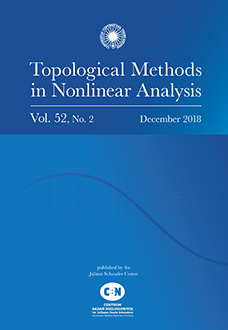Abstract
Let $\Omega$ be a domain in $\mathbb{R}^n$ ($n\geq 2$) of the form $\Omega=\Omega_{\text{out}}\setminus \overline{\Omega_{\text{in}}}$. Set $\Omega_D$ to be either $\Omega_{\text{out}}$ or $\Omega_{\text{in}}$. For $p\in (1,\infty)$, and $q\in [1,p]$, let $\tau_{1,q}(\Omega)$ be the first eigenvalue of \begin{alignat*}2 -\Delta_p u &=\tau \bigg(\int_{\Omega}|u|^q dx \bigg)^{({p-q})/{q}} |u|^{q-2}u &\quad&\text{in }\Omega,\\ u &=0&\quad&\text{on } \partial\Omega_D,\\\frac{\partial u}{\partial \eta}&=0&\quad& \text{on } \partial \Omega\setminus \partial \Omega_D. \end{alignat*}Under the assumption that $\Omega_D$ is convex, we establish the following reverse Faber-Krahn inequality$$\tau_{1,q}(\Omega)\leq \tau_{1,q}({\Omega}^\star),$$where ${\Omega}^\star=B_R\setminus \overline{B_r}$ is a concentric annular region in $\mathbb{R}^n$ having the same Lebesgue measure as $\Omega$ and such that
(i) (when $\Omega_D=\Omega_{\text{out}}$) $W_1(\Omega_D)= \omega_n R^{n-1}$, and $(\Omega^\star)_D=B_R$,
(ii) (when $\Omega_D=\Omega_{\text{in}}$) $W_{n-1}(\Omega_D)=\omega_nr$, and $(\Omega^\star)_D=B_r$.Here $W_{i}(\Omega_D)$ is the $i^{\text{th}}$ quermassintegral of $\Omega_D$. We also establish Sz.-Nagy's type inequalities for parallel sets of a convex domain in $\mathbb{R}^n$ ($n\geq 3$) for our proof.
Citation
Thazhe Veetil Anoop. Mrityunjoy Ghosh. "Reverse Faber-Krahn inequalities for Zaremba problems." Topol. Methods Nonlinear Anal. 64 (1) 257 - 278, 2024. https://doi.org/10.12775/TMNA.2023.055
Information





